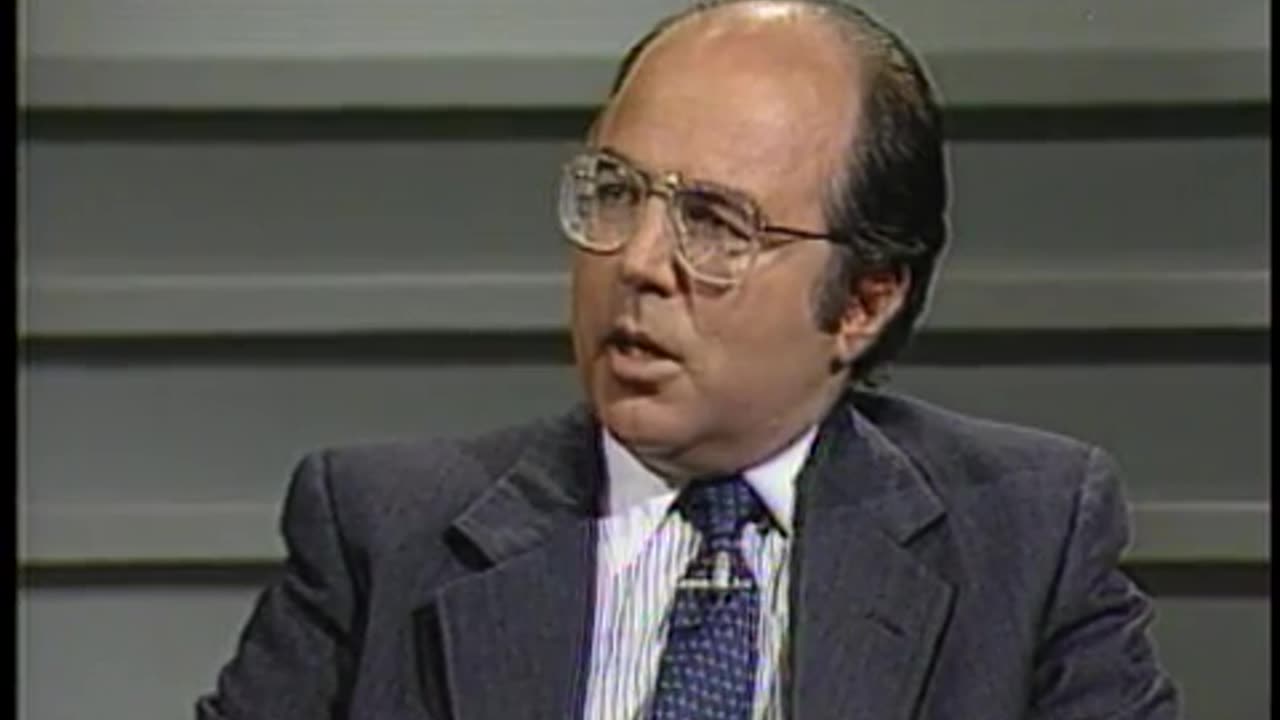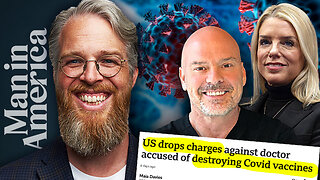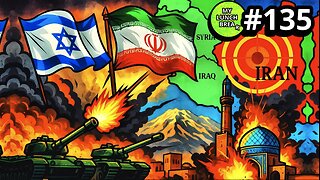Premium Only Content

What Is America Getting for Its Foreign Aid to Third World Countries?
Frances Moore Lappé (born February 10, 1944) is an American researcher and author in the area of food and democracy policy. She is the author of 19 books including the three-million-copy selling 1971 book Diet for a Small Planet, which the Smithsonian's National Museum of American History describes as "one of the most influential political tracts of the times." She has co-founded three organizations that explore the roots of hunger, poverty, and environmental crises, as well as solutions now emerging worldwide through what she calls Living Democracy. Her most recent books include Daring Democracy: Igniting Power, Meaning, and Connection for the America We Want, coauthored with Adam Eichen, and World Hunger: 10 Myths. with Joseph Collins. In 1987, she was awarded the Right Livelihood Award for "revealing the political and economic causes of world hunger and how citizens can help to remedy them."
Early life
Lappé was born in 1944 in Pendleton, Oregon, to John and Ina Moore and grew up in Fort Worth, Texas. After graduating from Earlham College in 1966, she married toxicologist and environmentalist Dr. Marc Lappé in 1967. They had two children, Anthony and Anna Lappé. She briefly attended University of California at Berkeley for graduate studies in social work.
Career
Political, nutritional and environmental research
Throughout her works Lappé has argued that world hunger is caused not by the lack of food but rather by the inability of hungry people to gain access to the abundance of food that exists in the world and/or food-producing resources because they are simply too poor. She has posited that our current "thin democracy" creates a mal-distribution of power and resources that inevitably creates waste and an artificial scarcity of the essentials for sustainable living.
Lappé makes the argument that what she calls "living democracy", i.e., democracy understood as a way of life, is not merely a structure of government. The three conditions essential for democracy, she writes in Daring Democracy and elsewhere, are the wide dispersion of power, transparency, and a culture of mutual accountability, not blaming. These three conditions enable humans to experience a sense of agency, meaning, and connection, which she describes as the essence of human dignity. Democracy is not only what we do in the voting booth but involves our daily choices of what we buy and how we live. She believes that only by "living democracy" can we effectively solve today's social and environmental crisises.
Lappé began her writing career early in life. She first gained prominence in the early 1970s with the publication of her book Diet for a Small Planet, which has sold several million copies.
In 1975, with Joseph Collins, she launched the California-based Institute for Food and Development Policy (Food First) to educate Americans about the causes of world hunger. In 1990, Lappé co-founded the Center for Living Democracy, a nine-year initiative to accelerate the spread of democratic innovations in which regular citizens contribute to problem-solving. She served as founding editor of the Center's American News Service (1995–2000), which placed stories of citizen problem-solving in nearly half the nation's largest newspapers.
In 2002, Lappé and her daughter Anna established the Small Planet Institute based in Cambridge, Massachusetts, a collaborative network for research and popular education to bring democracy to life. With her daughter, she traveled the world and wrote Hope's Edge. The two also co-founded the Small Planet Fund,[1] channeling resources to democratic social movements worldwide.
In 2006 she was chosen as a founding councilor of the Hamburg-based World Future Council. She is also a member of the International Commission on the Future of Food and Agriculture and the National Advisory Board of the Union of Concerned Scientists. She serves as an advisor to the Calgary Centre for Global Community and on the board of David Korten's People-Centered Development Forum. In 2009 she joined the advisory board of Corporate Accountability International's Value the Meal campaign.[2] Lappé is a Contributing Editor to YES! Magazine.
Teaching positions
Lappé has also held various teaching and scholarly positions:
From 1984-1985, she was a visiting scholar at the Institute for the Study of Social Change at the University of California, Berkeley.
From 2000-2001, she was a visiting scholar at the Massachusetts Institute of Technology, Cambridge, Massachusetts.
In 2003, she taught with Dr. Vandana Shiva in Dehra Dun, India, about the roots of world hunger, sponsored by the Navdanya researching and agricultural demonstration center.
In 2004, she taught a course on Living Democracy at Schumacher College in England.
In 2006 and 2008, she was a visiting professor at Suffolk University, Boston.[3]
In 2013-2014, she was the Andrew W. Mellon Distinguished Fellow in Environmental Studies at Colby College in Maine.[4]
Recognition
Historian Howard Zinn wrote: "A small number of people in every generation are forerunners, in thought, action, spirit, who swerve past the barriers of greed and power to hold a torch high for the rest of us. Lappé is one of those." The Washington Post says: "Some of the twentieth century's most vibrant activist thinkers have been American women – Margaret Mead, Jeannette Rankin, Barbara Ward, Dorothy Day – who took it upon themselves to pump life into basic truths. Frances Moore Lappé is among them."
Lappé receiving the 2008 James Beard Foundation Humanitarian of the Year Award
In 2008, she was honored by the James Beard Foundation as the Humanitarian of the Year. In the same year, Gourmet Magazine named Lappé among 25 people (including Thomas Jefferson, Upton Sinclair, and Julia Child), whose work has changed the way America eats. Diet for a Small Planet was selected as one of 75 Books by Women Whose Words Have Changed the World by members of the Women's National Book Association in observance of its 75th anniversary.
Lappé has received 19 honorary doctorates from distinguished institutions, including the University of Michigan, Kenyon College, Allegheny College, Lewis and Clark College, Grinnell College and University of San Francisco. In 1987 in Sweden, Lappé became the fourth American to receive the Right Livelihood Award. In 2003, she received the Rachel Carson Award from the National Nutritional Foods Association. She was selected as one of twelve living "women whose words have changed the world" by the Women's National Book Association.
Family
Lappé's son, Anthony, is a New York City-based, award-winning media producer (Invisible Hand Media), whose work has appeared on Vice.com and the History Channel. Her daughter, Anna, who lives in Berkeley, California, is the author of Grub and Diet for a Hot Planet. She leads Real Food Media.
Writings
Frances Moore Lappé's works have been translated into 15 languages, the most recent of which is a Chinese publication of Hope's Edge.[5]
Diet for a Small Planet, Ballantine Books, 1971, 1975, 1982, 1991. ISBN 0-345-02378-1
Great Meatless Meals (with Ellen Buchman Ewald), Ballantine Books, 1974, 1976, 1981, 1985.
Food First: Beyond the Myth of Scarcity (co-authored by Joseph Collins, collaboration with Cary Fowler), Houghton Mifflin, 1977, Ballantine Books, 1979.
Now We Can Speak: A Journey Through Nicaragua, Food First Books, 1982.
What To Do After You Turn Off the T.V., Ballantine Books, 1985.
World Hunger: Twelve Myths (with Joseph Collins), Grove Press, 1986, 1998.
Rediscovering America's Values, Ballantine Books, 1989
The Quickening of America: Rebuilding Our Nation, Remaking Our Lives (with Paul Martin Du Bois), Jossey-Bass, 1994.
Hope's Edge: The Next Diet for a Small Planet (with Anna Lappé), Tarcher/Penguin, 2002.
You Have the Power: Choosing Courage in a Culture of Fear (with Jeffrey Perkins), Tarcher/Penguin, 2004.
Democracy's Edge: Choosing to Save Our Country by Bringing Democracy to Life, Jossey-Bass, 2005.
Getting A Grip: Clarity, Creativity, and Courage in a World Gone Mad, Small Planet Media, 2007.
Getting A Grip 2: Clarity, Creativity, and Courage for the World We Really Want, Small Planet Media, 2010.
EcoMind: Changing the Way We Think to Create the World We Want, Small Planet Media, 2011
World Hunger: Ten Myths (with Joseph Collins), Grove Press, 2015.
Daring Democracy: Igniting Power, Meaning, and Connection for the America We Want (co-authored by Adam Eichen), Beacon Press, 2017.
References
"Small Planet Fund".
"Value the Meal Advisory Board". Archived from the original on April 6, 2010. Retrieved December 31, 2009.
Frances Moore Lappé, Small Planet Institute
"Frances Moore Lappé".
New Chinese Publication Promotes Global Outreach of Ideas, Small Planet Institute (February 2011)
External links
Wikiquote has quotations related to Frances Moore Lappé.
Small Planet Institute
Right Livelihood Award website
Interview on Humankind Public Radio
Recent articles
[1] The New York Times Magazine Interview 2019: Frances Moore Lappé changed how we eat. She wants to do the same for our democracy.
Retire Ronald McDonald--Do it for our kids! Frances writes that Ronald McDonald should be retired and McDonald's should halt advertising to kids, March 2010
The Movement Mother An interview of Frances Moore Lappé with her son, Anthony Lappé, June 2009
The City that Ended Hunger Frances writes about the city of Belo Horizonte, Brazil in Yes MagazineFebruary 2009
Videos
Burger King's Flawed Strategy on YouTube Frances Moore Lappé on Fox News
James Beard Awards 2008 Frances Moore Lappé video on YouTube
Interview on Democracy Now!, July 9, 2008
On KEXP 90.3 FM in Seattle, Washington on YouTube An interview with Mike McCormick, producer of Mind Over Matters, July 2008
vte
Veganism and vegetarianism
Authority control Edit this at Wikidata
Categories:
American democracy activistsWriters about activism and social changeAmerican motivational writersWomen motivational writersAmerican food writersAmerican cookbook writersNautilus Book Award winnersEarlham College alumniPeople from Pendleton, Oregon1944 birthsLiving peopleSoy researchersWomen food writersWomen cookbook writersAmerican political writersAmerican women non-fiction writers21st-century American women
https://en.wikipedia.org/wiki/Frances_Moore_Lapp%C3%A9
George B. N. Ayittey (13 October 1945 – 28 January 2022) was a Ghanaian economist, author, and president of the Free Africa Foundation in Washington, D.C. He was a professor at American University,[1][better source needed] and an associate scholar at the Foreign Policy Research Institute.[2]
He championed the argument that "Africa is poor because she is not free," that the primary cause of African poverty is less a result of the oppression and mismanagement by colonial powers, but rather a result of modern oppressive native autocrats and socialist central planning policies.[3] He also went beyond criticism of the status quo to advocate for specific ways to address the abuses of the past and present; specifically he called for democratic government, debt reexamination, modernized infrastructure, free market economics, and free trade to promote development.
Life
Ayittey attended Adisadel College for his secondary education and held a B.Sc. in economics from the University of Ghana, Legon, an M.A. from the University of Western Ontario in Canada, and a Ph.D. from the University of Manitoba. He taught at Wayne State College and Bloomsburg University of Pennsylvania. He held a National Fellowship at the Hoover Institution in 1988–89, and then joined The Heritage Foundation as a Bradley Resident Scholar.[2] Ayittey served on the advisory board of Students For Liberty and also worked closely with the Atlas Network.
He founded The Free Africa Foundation in 1993 to serve as a catalyst for reform in Africa.[4] In 2008, Ayittey was listed by Foreign Policy as one of the "Top 100 Public Intellectuals" who "are shaping the tenor of our time."[5]
Political views
Ayittey believed there are three keys to successfully rescuing Africa from oppressive despotism:
First, he advocated forming coalitions consisting of small groups of "elders" who have no political ties and monitor the activities of the various opposition groups. Ayittey explains, "They must be able to reach out to all the opposition groups."[6] "The council should bring all of the opposition into an alliance ", which would prevent dictators from overpowering severely divided competition.
Second, nations have to gain control of the civil service, security forces, judiciary, election centers, and national bank. Ayittey saw control of at least one of these resources as central to subverting dictatorial power in African countries. These organizations are currently staffed by cronies of dictators throughout Africa.
Third, and finally, a nation has to use the correct sequence of reforms.
Personal life
George Ayittey's younger sister was the politician, Sherry Ayittey. Ayittey died on 28 January 2022[7] and was buried on 8 April 2022.[8]
Published works
Indigenous African Institutions, Transnational Publishers, 1991; 2nd ed., 2004
The Blueprint for Ghana's Economic Recovery, Africana Publishers, 1997
Africa Betrayed, St. Martin's Press, 1992 (Africa Betrayed won the 1992 Mencken Award for Best Book.)[9]
Africa in Chaos, St. Martin's Press, 1998.[10]
Africa Unchained: the blueprint for development, Palgrave/MacMillan, 2004
Defeating Dictators: Fighting Tyrants in Africa and Around the World published September 2011.
Applied Economics for Africa, Atlas Network, 2018.
References
https://www.linkedin.com/in/ayittey LinkedIn Profile of George Ayittey
"Bio at Foreign Policy Research Institute". Archived from the original on 7 April 2010. Retrieved 31 January 2010.
"BBC World Service | the Forum".
"Free Africa Foundation". www.freeafrica.org. Retrieved 17 October 2017.
Top 100 Public Intellectuals, Foreign Policy
mariam, al. "Ayittey's War on African Dictators". Online article. huffingpost. Archived from the original on 3 September 2011. Retrieved 28 December 2011.
"In Memory of Prof. George B. N. Ayittey". Ever Loved. Archived from the original on 12 April 2022. Retrieved 11 April 2022.
"Famous US-based Ghanaian Author, Economist, George Ayittey dead". My News Ghana. 8 April 2022. Retrieved 8 April 2022.
"The Mencken Awards: 1982–1996".
Reviewed by Jeremy Harding for The New York Times
External links
Bio at A World Connected
Human Rights: Africa's Shady Politicians Are at Root of Continent's Destitution, commentary by Dr. Ayittey
Appearances on C-SPAN
George Ayittey at TED Edit this at Wikidata
TED Talks: George Ayittey on Cheetahs vs. Hippos (TEDGlobal 2007)
George Ayittey on Prabook
Authority control Edit this at Wikidata
International
ISNI VIAF WorldCat
National
Norway Germany Israel Belgium United States Latvia Czech Republic Netherlands
Other
IdRef
Categories:
1945 births2022 deathsAmerican University faculty and staffGhanaian academicsGhanaian economistsThe Heritage FoundationUniversity of Ghana alumniUniversity of Manitoba alumniUniversity of Western Ontario alumni20th-century economistsGa-Adangbe peopleAlumni of Adisadel College
https://en.wikipedia.org/wiki/George_Ayittey
United States foreign aid, also known as US foreign assistance consists of a variety of tangible and intangible forms of assistance the United States gives to other countries. Foreign aid is used to support American national security and commercial interests and can also be distributed for humanitarian reasons.[1] Aid is financed from US taxpayers and other revenue sources that Congress appropriates annually through the United States budget process. It is dispersed through "over 20 U.S. government agencies that manage foreign assistance programs,"[2] although about half of all economic assistance is channeled through the United States Agency for International Development (USAID).
The primary recipients of American foreign aid are developing countries, countries of strategic importance to the United States, and countries recovering from war. While the United States has given aid to other countries since 1812, government-sponsored foreign aid was expanded during World War II, with the current aid system implemented in 1961.[3] The largest aid programs of the post-war period were the Marshall Plan of 1948 and the Mutual Security Act of 1951-61.
Quantitatively, the United States spends the most on foreign aid of any country; however, as a percent of GDP, American foreign aid spending ranks near the bottom compared to other developed countries.[3] Foreign aid typically receives bipartisan support in Congress[4] as it is seen to promote global economic development and in turn, American national security.[3] However, foreign aid remains unpopular with the American public,[5] possibly due to overestimations of the scale of aid spending by the federal government.[6]
History
Earliest instances
One of the earliest and least known instances of US foreign aid is also a good example of how aid has a long history of being used as a tool of foreign policy. On May 6, 1812, despite continued hostilities over independence from British colonial rule, US Senator from Kentucky Henry Clay signed a bill appropriating $50,000 for disaster relief food aid to Venezuela after a massive earthquake devastated the capitol, Caracas, that was enacted on May 8 by the 12th Congress (Chap. LXXIX). Coincidentally, Venezuela was also fighting a war for independence from Spanish colonial rule, from 1810 to 1823. The food aid was accompanied by diplomat Alexander Scott, who stated that this aid was “strong proof of the friendship and interest which the United States…has in their welfare…and to explain the mutual advantages of commerce with the United States.” A case may be made that some motivation for this act of generosity was diplomatic (i.e.: transactional) in nature, insofar as that both nations were seeking diplomatic recognition as sovereign from colonizers, and that this gesture would elicit such a desired reciprocal response. Later, in 1927, the US Congress appropriated $41,000 for the creation and transportation of a statue in Henry Clay's likeness to be erected in Caracas, where by all accounts it remains to this day, memorializing Clay as a symbol of US generosity abroad.
World War I
During World War I, the Committee for Relief in Belgium (CRB), which sent food to the hungry in that war-torn country, received $387 million from the U.S. government (as well as $314 million from the British and French governments and about $200 million from non-governmental sources). These government monies were given in the form of loans, but a considerable portion of those loans was forgiven.[7]
After the war, the American Relief Administration, directed by Herbert Hoover who had also been prominent in the CRB, continued food distribution to war-devastated European countries. It also distributed food and combated typhus in the Russian Soviet Federative Socialist Republic during its famine of 1921–23. The U.S. Congress appropriated $20 million for the ARA under the Russian Famine Relief Act of 1921.
World War II
Levels of United States aid increased greatly during World War II, mainly on account of the Lend-lease program. United States government aid remained high in the decade after the war because of contributions to European reconstruction, and competition for influence versus the Communist powers in the first years of the Cold War. By 1960, the annual aid amount had receded to about half of what it was in the early post-war years, and, in inflation-adjusted terms, it has remained at that level—with some fluctuations—until the present.[8]
The Lend-lease program, which began in 1941 (before the U.S. entrance in the war) was an arrangement whereby the United States sent large amounts of war materials and other supplies to nations whose defense was considered vital to the defense of the United States. It began with the passage by Congress of the Lend-lease act (PL 77-11) on 11 March 1941.[9] Initially, the main recipient was the United Kingdom; the Soviet Union began receiving supplies (paid for in gold) in June 1941 outside of Lend-lease, and was included in the Lend-lease agreement in November 1941. By the end of the war, most of the Allied countries had been declared eligible for Lend-lease aid, although not all received it. By the time the program was ended by President Harry S. Truman in August 1945, more than $50 billion worth of supplies had been disbursed, of which the Commonwealth countries received $31 billion and the Soviet Union $11 billion. Although formally the material was loaned, in the end only partial repayment was demanded.
A second wartime aid program, the United Nations Relief and Rehabilitation Administration (UNRRA), was founded in November 1943, by 44 Allied governments, for the purpose of assisting and resettling displaced victims of the war.[10] Its initial focus was on assisting people in areas the Allies had captured from the Axis powers: distributing food, clothing and other essentials, and helping with medical care and sanitation. Later it also assisted in the resumption of agriculture and industry. Each of the 44 signatories was supposed to contribute one percent of its national income.[11] The chief beneficiaries were China, Czechoslovakia, Greece, Italy, Poland, the Ukrainian SSR and Yugoslavia. UNRRA returned about 7 million displaced people to their countries of origin and provided refugee camps for about one million who were unwilling to be repatriated. UNRRA ceased operations in Europe in mid-1947;[12] some of its activities in Asia continued under other auspices until early 1949. In the end 52 countries had contributed as donors. Contributions from governments and private organizations during the four years of the program totaled over $3.8 billion; more than half of that was from the United States.
Cold War
After the war, the United States began giving large amounts of aid to Greece and Turkey under the Truman doctrine. Both countries were experiencing civil strife between communist and anti-communist factions, and the President and his advisors feared that their efforts to keep European countries from adopting communism might be about to suffer a serious setback. In December 1946, Greek Prime Minister Konstantinos Tsaldaris visited Washington and requested additional United States aid. Truman promulgated his containment doctrine in early 1947, a major component of which was to be aid to the world's poor countries in order to blunt the appeals of radicalism to their hungry peoples and to bolster their anti-communist political elements. In May 1947 the U.S. government granted Greece $300 million in military and economic aid. Turkey received $100 million. The U.S. government gave Greece $362 million in 1949, and U.S. aid to Greece generally remained over $100 million annually until 1998.[13] After the Chinese Civil War and the Korean War, U.S. military aid both to Europe and the developing "Third World" increased, with military aid composing 95 percent of all U.S. aid by 1954 and going largely to countries in Cold War proxy conflicts against communist forces.[14]
The most well-known, and largest, United States aid program in the immediate post-war years was the European Recovery Program (ERP). More often known as the Marshall Plan, it was the creation of George Kennan, William Clayton, and others at the U.S. State Department under Secretary of State George Marshall. Publicly suggested by Marshall in June 1947, and put into action about a year later, the Plan was essentially an extension of the Greece–Turkey aid strategy to the rest of Europe. The U.S. administration considered the stability of the existing governments in Western Europe vital to its own interests. On 3 April 1948, President Truman signed the Economic Cooperation Act, establishing the Economic Cooperation Administration (ECA) to administer the program, and actual disbursements got underway. The focus was on promoting production, stabilizing currencies, and promoting international trade. To be eligible for the aid, a country had to sign an agreement with the United States government committing itself to the Act's purposes. The Communist countries were formally invited to participate in the Plan although Secretary Marshall thought it unlikely that they would accept and they did in fact decline the aid. Also in 1948, the United States and the recipient countries created the Organisation for European Economic Cooperation (OEEC – it became the OECD in 1961) to coordinate the use of the aid. A large portion of the money given was used to purchase goods from the United States, and the ships used to transport the goods had to be of U.S. nationality. Military aid was not part of the plan.[15] The Marshall Plan ended in December 1951.[16] The United States government gave out about $12.5 billion under the Plan during its three-and-a-half-year existence. The countries receiving the most were Great Britain ($3.3 billion), France ($2.3 billion) and West Germany ($1.4 billion).[17]
Meanwhile, President Truman had started the practice of giving aid for the development of poorer countries. This was signalled in the famous Point Four of his second-term inauguration speech. Initially this assistance was mainly in the form of technical cooperation, but during the 1950s, grants and concessional loans came to play a large role in development aid, within the framework of the Mutual Security Act and alongside foreign military assistance and defense support.[18][19]
From 1945 to 1953 – U.S. provides grants and credits amounting to $5.9 billion to Asian countries, especially Republic of China/Taiwan ($1.051 billion), India ($255 million), Indonesia ($215 million), Japan ($2.44 billion), South Korea ($894 million), Pakistan ($98 million) and the Philippines ($803 million). In addition, another $282 million went to Israel and $196 million to the rest of the Middle East. The main category was economic aid, but some military aid was provided.[20] All this aid was separate from the Marshall Plan.[21]
After the Cold War
Congress passed the Foreign Assistance Act on 4 September 1961, reorganizing U.S. foreign assistance programs and separating military and non-military aid. The Act was established by President John F. Kennedy two months later. USAID became the first U.S. foreign assistance organization whose primary focus was long-term economic and social development. As the Cold War waned foreign aid spending was cut dramatically from 0.44% of GDP in 1985 to 0.16% Of GDP in 2002. [22]
President Barack Obama announced to the UN Millennium Development Goals summit in September 2010 that the United States was changing its policy towards foreign aid. The President said the country would focus more on effectiveness, and make sure donated food, medicine, and money help countries get to the point where they no longer require such aid. Infrastructure set up for the President's Emergency Plan for AIDS Relief would be used to build capacity in local health care systems to improve maternal and child health, and also fight tropical diseases. The new policy would increase the profile and participation of the United States Agency for International Development (USAID), which would coordinate more directly with the National Security Council and Secretary of State Hillary Clinton.[23] Some observers criticized the link with national security and foreign policy as unhelpful for the impoverished, and others lamented the attempted streamlining as only adding more bureaucracy.[23]
A study in 2006 found that U.S. foreign assistance to a country rose by an average of 59% when that country occupied one of the rotating seats on the UN Security Council, and fell back to normal levels when it vacated the seat.[24]
Allocation
In fiscal year 2020 (October 1, 2019 - September 30, 2020), the US government allocated $51.05 billion US dollars in economic and military assistance to foreign countries. Of this total, $39.41 billion dollars was spent on economic assistance, $25.64 billion of which was dispersed by USAID. The remaining $11.64 billion dollars was spent on military assistance.[25] Foreign aid obligations are listed by recipient country and implementing agency in the tables below.
By country
Top 25 Recipient Countries of U.S. Foreign Aid FY 2020, Reported in $US millions, Obligations[25][26] Country Economic and Military Assistance FY 2020, $US millions Economic Assistance FY 2020, $US millions Military Assistance FY2020, $US millions
Afghanistan 3,951.093 1,189.363 2,761.464
Israel 3,310.857 10.857 3,300.000
Jordan 2,593.955 2,089.982 503.973
Egypt 1,471.127 169.108 1,302.018
Ethiopia 1,213.189 1,209.417 3.771
Iraq 1,180.527 632.379 548.148
Nigeria 1,114.808 1,104.902 9.906
South Africa 1,114.214 1,114.011 .203
Democratic Republic of the Congo 964.590 959.518 5.072
Syria 837.125 837.125 0
Lebanon 830.594 586.085 244.508
Kenya 830.483 826.394 4.088
Colombia 812.554 745.032 67.521
Uganda 800.424 797.641 2.783
South Sudan 759.675 739.175 20.500
Somalia 689.600 551.237 138.362
Ukraine 679.883 395.874 284.009
Tanzania 622.291 620.801 1.489
Mozambique 567.741 566.516 1.224
Bangladesh 559.076 542.151 16.925
Yemen 556.544 555.380 1.163
Zambia 451.289 450.941 .348
Philippines 387.446 222.361 165.085
Malawi 367.366 366.843 .522
Sudan 359.530 358.510 1.020
By agency
U.S. Foreign Aid by Implementing Agency FY2015-FY2020, Reported in $US millions, Obligations[25] Implementing Agency 2015 2016 2017 2019 2020
U.S. Agency for International Development 19,412.06 19,358.09 20,548.50 21,150.410 25,643.616
Department of Defense 14,823.81 15,347.51 14,500.82 14,079.172 11,797.270
Department of State 7,508.35 5,836.87 7,664.03 7,007.194 7,905.923
Department of Health and Human Services 2,640.30 4,217.89 2,659.52 2,318.239 2,759.851
Department of the Treasury 2,647.78 2,286.03 1,846.36 1,556.923 1,875.993
Peace Corps 441.56 440.16 479.34 458.592 377.720
Department of the Interior 233.56 280.88 240.84 294.063 274.024
Department of Energy 590.62 535.09 432.48 154.646 163.086
Department of Labor 81.18 44.17 24.58 45.673 57.998
Inter-American Foundation 26.41 27.47 30.09 28.739 42.621
Department of Agriculture 211.57 382.06 290.26 332.245 39.911
Trade and Development Agency 51.11 58.10 67.77 30.340 34.805
Millennium Challenge Corporation 429.57 963.23 1,012.08 646.470 33.664
African Development Foundation 20.34 27.15 20.23 22.470 22.127
Department of the Army 117.87 85.72 2.09 14.970 8.614
Department of the Navy 20.49 7.56 0 14.784 7.894
U.S. International Development Finance Corporation N/A N/A N/A N/A 4.957
Department of the Air Force 181.00 8.59 7.00 7.207 3.670
Environmental Protection Agency 16.79 17.96 21.48 12.131 2.465
Department of Justice 13.04 (4.81) 10.21 3.359 1.436
Department of Transportation 1.15 0.29 0.03 .112 1.129
Department of Commerce 6.45 6.42 7.63 .120 .866
Department of Homeland Security 2.78 11.43 4.44 3.391 .297
Federal Trade Commission 0 0 0 .167 .034
Public opinion
This section possibly contains original research. Please improve it by verifying the claims made and adding inline citations. Statements consisting only of original research should be removed. (December 2017) (Learn how and when to remove this template message)
Crystal Clear app kedit.svg
This section may need to be rewritten to comply with Wikipedia's quality standards. You can help. The talk page may contain suggestions. (December 2017)
Foreign aid is a highly partisan issue in the United States, with liberals, on average, supporting government-funded foreign aid much more than conservatives do,[27] who tend to prefer to provide foreign aid privately.
Several Interviews with 1,012 adult Americans were conducted by telephone by Opinion Research Corporation in January 2011. Published by CNN, the response was that 81% felt that reducing aid to foreign countries was a good way to reduce the federal budget deficit, while 18% thought aid was more important than reducing deficit.[28] Thomas Pogge, Director of the Global Justice Program and Leitner Professor of Philosophy and International Affairs at Yale University, has predicted that public opinion will not change even while the hardships suffered by poor people are rising, partly as a result of the Great Recession.[29] Some claim the U.S. is helping corrupt governments with the aid.
Worldwide opinion of the United States improves with contributions to developing countries.[30]
Public knowledge of aid polls have been done assessing the knowledge of the US Public in regards to how much they know about the government's foreign aid spending. A poll conducted by World Public Opinion in 2010 found that the average estimate for how much of the government's budget is spent on foreign aid was 25 percent.[31] The average amount proposed by the public was 10 percent of the federal government's budget be used on foreign aid.[31] In actuality, less than 1 percent of the US federal budget goes towards foreign aid.[31] Less than 19 percent of respondents thought that the percent of the budget that goes towards foreign aid was less than 5 percent.[31] Steven Kull, director of PIPA, relates this overestimation towards an increase in hearing about foreign aid efforts during the Obama administration, but estimates of foreign aid have always been high.[31]
A poll conducted in 2013 by the Pew Research Center found that the majority of Americans wanted to either maintain or increase spending on all US government initiatives except foreign aid. This is attributed, by Alice C. Hu, to a gross misconception of how much of the federal budget is actually spent on foreign aid.[32]
Opinions change
A study by The Washington Post from 2017 shows that Americans can change their opinions on U.S. foreign aid, depending on how it is presented to them.[33] The percentage of people who were provided no argument regarding foreign aid and thought the United States spends too much on it was 67 percent.[33] The percentage of people who were provided a positive argument for foreign aid and thought the United States spent too much on it was 28 percent.[33] The percentage of people who were provided a negative argument against foreign aid and thought that the United States spends too much on it was 88 percent.[33]
Because the U.S. public's attitude toward foreign aid is impacted by the positive or negative tone of messages on aid, Steven Kull, Director of the Program on International Policy Attitudes, laid out steps to preserve or create a positive outlook on U.S. foreign aid.[34]
Understand the attacks on foreign aid.
Do not frame questions about public opinion in terms of priorities because people are likely to prioritize domestic issues.
Emphasize that only 1 percent of the federal budget goes towards foreign aid, as the Clinton administration did in the 1990s.
Americans feel that the United States does more than its fair share on the world stage, so differentiate between foreign aid and military spending.
Note that other countries, as part of multilateral frameworks, are doing their part in contributing to foreign aid efforts.
Address concerns about aid effectiveness, including sharing success stories in providing aid, articulating the role of international and local NGOs in implementing foreign aid, and mobilizing trusted public figures to address effectiveness.
Point out that foreign aid is a safe way to improve U.S. relations with other nation-states, therefore promoting self-interest.[34]
Recipients of foreign aid
A study by Andy Baker, a political scientist at the University of Colorado at Boulder, found that Americans are more likely to support foreign aid going to an African country than they are to support foreign aid going to an Eastern European country.[35] Respondents wanted to cut aid going to those of European descent by 40 percent more than of those of African descent. Baker attributes this to a paternalistic view Americans have of themselves over those of African descent.[35]
Amount spent and destination
Due to the size of the U.S. federal budget, the 0.7 percent put towards foreign aid comprises a significant proportion of all foreign aid flows including other donors.[32] Most U.S. foreign aid does not go to other governments due to skepticism about corruption in other countries. There is a fear among the American people that foreign aid is funneled and used to increase the personal wealth of corrupt government leaders of foreign countries. However, about 85 percent of foreign aid goes to non-governmental organizations (NGOs) and U.S.-government contractors, meaning that most of foreign aid is not being given directly to foreign governments.[32]
See also
Compact of Free Association
Criticism of United States foreign policy
Development Assistance Database
Feed the Future Initiative
Foreign Assistance Act
Foreign policy of the United States
Millennium Challenge Corporation
United States Foreign Military Financing
United States military aid
USAID
Canadian International Development Agency
General:
List of development aid country donors
References
Morgenster, Emily M.; Brown, Nick M. (January 2022). Foreign Assistance: An Introduction to U.S. Programs and Policy (Report). Congressional Research Service. Archived from the original on 12 July 2022. Retrieved 10 July 2022.
"Agencies | ForeignAssistance.gov". www.foreignassistance.gov. Archived from the original on 21 January 2020. Retrieved 7 January 2020.
"How Does the U.S. Spend Its Foreign Aid?". Council on Foreign Relations. Archived from the original on 7 January 2021. Retrieved 3 January 2021.
Liz Schrayer (3 September 2016). "The Surprise Bipartisan Success Story of Congress: American Aid". Archived from the original on 9 February 2018. Retrieved 9 August 2017.
"Most See U.S. Foreign Aid As A Bad Deal for America". Rasmussen. 20 March 2017. Archived from the original on 27 June 2019. Retrieved 9 September 2017.
Klein, Ezra (7 November 2013). "The budget myth that just won't die: Americans still think 28 percent of the budget goes to foreign aid". The Washington Post. Archived from the original on 4 November 2020. Retrieved 12 December 2020.
Annotated CRB documents Archived 2 December 2007 at the Wayback Machine, retrieved September 2009. The U.S. aid commenced after April 1917; Britain had been contributing since 1914. The amounts contributed by the governments are from the table near the beginning of the web page. 200 million is calculated as 22 percent (100 – 78 percent) of the 900 million distributed by the committee (mentioned in the discussion preceding the table).
This paragraph refers to inflation-adjusted ("constant-dollar") levels. Generally, the other data in this section is in historical dollars. USAID, Greenbook, interactive version, "Program Reports"; then selecting "Custom Report" allows you to get data going back to 1946. Retrieved September 2009.
United States government (ourdocuments.gov), Lend-Lease Act (1941), essay about the Act Archived 16 March 2009 at the Wayback Machine, and transcript of the Act Archived 13 August 2009 at the Wayback Machine. Retrieved September 2009.
Although the UNRRA was called a "United Nations" agency, it was established prior to the founding of the United Nations. The explanation for this is that the term 'United Nations' was used at the time to refer to the Allies of World War II, having been originally coined for that purpose by Roosevelt in 1942.
Assisting the victims of war: 'nations will learn to work together only by actually working together.' (United Nations Relief and Rehabilitation Administration). U.N. Publications, 1994.
United Nations, Assisting the victims of war ..., op cit., says the UNRRA decided on 16 August 1947 to liquidate itself, "a process completed in 1948;" Infoplease (Columbia Encyclopedia), "United Nations Relief and Rehabilitatin Administration" Archived 26 August 2009 at the Wayback Machine, says UNRRA discontinued its operations in Europe on 30 June 1947.
These amounts are in historical (not inflation-adjusted) dollars. USAID, Greenbook Historical query Archived 25 June 2009 at the Wayback Machine, select Country Reports >> Greece, Custom Report >> the data you want, and the year (Ctrl+A selects all years). Retrieved September 2009. Also, Time Magazine, "Greece: The Poly-Papadopoulos", 3 April 1972; retrieved September 2009.
Westad, Odd Arne (24 October 2005). The Global Cold War: Third World Interventions and the Making of Our Times (1 ed.). Cambridge University Press. pp. 26–27. doi:10.1017/cbo9780511817991.002. ISBN 978-0-521-85364-4. Archived from the original on 20 April 2023. Retrieved 29 November 2021.
This and the information about U.S. goods and ships is from u-s-history.com "Marshall Plan" Archived 20 April 2023 at the Wayback Machine, retrieved September 2009.
Spartacus.schoolnet.co.uk, "Marshall Plan" Archived 9 March 2009 at the Wayback Machine, retrieved September 2009.
Other sources on the Marshall Plan used here include infoplease.com "Marshall Plan" Archived 20 April 2023 at the Wayback Machine, and The Marshall Foundation, "The Marshall Plan" Archived 22 June 2010 at the Wayback Machine.
Haviland, H. Field (September 1958). "Foreign Aid and the Policy Process: 1957". American Political Science Review. 52 (3): 689–724. doi:10.2307/1951900. ISSN 1537-5943. JSTOR 1951900. S2CID 144564474. Archived from the original on 8 March 2021. Retrieved 3 March 2021.
Morgner, Aurelius (1967). "The American Foreign Aid Program: Costs, Accomplishments, Alternatives?". The Review of Politics. 29 (1): 65–75. doi:10.1017/S0034670500023731. ISSN 0034-6705. JSTOR 1405813. S2CID 145492668. Archived from the original on 27 May 2020. Retrieved 17 September 2017.
All data from the official document: U.S. Bureau of the Census, Statistical Abstract of the United States: 1954 (1955) table 1075 pp 899–902 online edition file 1954-08.pdf Archived 3 January 2017 at the Wayback Machine
Harry Bayard Price, The Marshall Plan and its Meaning (Cornell UP, 1955), pp 179–219.
Farrell, Tiffany; Friedman, Marcia A.; Kolb, Pherabe; Walker, Tim (2005). Current Issues. Alexandria, VA: Close Up Foundation. p. 208. ISBN 1-930810-15-6.
[1] Archived 24 November 2010 at the Wayback Machine, Bristol 2010.
Kuziemko, Ilyana; Werker, Eric (1 October 2006). "How Much Is a Seat on the Security Council Worth? Foreign Aid and Bribery at the United Nations". Journal of Political Economy. 114 (5): 905–930. doi:10.1086/507155. ISSN 0022-3808. S2CID 38308185. Archived from the original on 15 May 2021. Retrieved 5 March 2021.
"FA.gov". ForeignAssistance.gov. Archived from the original on 17 December 2021. Retrieved 17 December 2021.
Sharp, Jeremy M. (10 April 2018). "U.S. Foreign Aid to Israel [April 10, 2018]". Archived from the original on 1 July 2021. Retrieved 12 March 2019.
"Peter Hays Gries, The Politics of American Foreign Policy: How Ideology Divides Liberals and Conservatives over Foreign Affairs (Stanford, 2014), pp. 108–112". Archived from the original on 12 March 2018. Retrieved 30 December 2014.
"Cnn Research Poll" (PDF). CNN. Archived (PDF) from the original on 3 February 2016. Retrieved 4 June 2015.
Pogge, Thomas (2014). "Are We Violating the Human Rights of the World's Poor?" (PDF). Yale Human Rights & Development Law Journal. 17 (1): 31. Retrieved 4 June 2015.
Goldsmith, Benjamin E.; Horiuchi, Yusaku; Wood, Terence. "Doing well by doing good: foreign aid improves opinions of the U.S." Washington Post. Archived from the original on 4 June 2015. Retrieved 4 June 2015.
WPO Admin (29 November 2010). "American Public Vastly Overestimates Amount of U.S. Foreign Aid". World Public Opinion. Archived from the original on 1 December 2017. Retrieved 23 November 2017.
Hu, Alice C. (11 March 2015). "Foreign Aid and the 28 Percent Myth". Harvard International Review. Archived from the original on 1 December 2017. Retrieved 23 November 2017.
Hurst, Hawkins, Tidwell, Reuben, Darren, Taylor (4 May 2017). "Americans love to hate foreign aid, but the right argument makes them like it a lot more". The Washington Post. Archived from the original on 6 December 2017. Retrieved 23 November 2017.
Kull, Steven. “Preserving American Public Support for Foreign Aid.” Archived 1 December 2017 at the Wayback Machine Brookings Blum Roundtable Policy Briefs, pp. 53–60.
Baker, Andy. 2015. “Race, Paternalism, and Foreign Aid: Evidence from U.S. Public Opinion.” American Political Science Review 109 (1): 93–109.
External links
U.S. Foreign Assistance dashboard
Brief Chronology and Highlights of the History of U.S. Foreign Assistance Activities
Criticism of U.S. Foreign Aid from the Dean Peter Krogh Foreign Affairs Digital Archives
Rethinking U.S. Aid from the Dean Peter Krogh Foreign Affairs Digital Archives
Further reading
This section may require cleanup to meet Wikipedia's quality standards. The specific problem is: formatting and linking. Please help improve this section if you can. (October 2012) (Learn how and when to remove this template message)
USG sources of data on United States aid are:
Foreign Aid Explorer
U.S. Overseas Loans and Grants: Obligations and Loan Authorizations, July 1, 1945 – September 30, 2013
ForeignAssistance.gov
Non-USG sources of data on United States aid are:
Publications of the Development Assistance Committee (DAC) of the Organisation for Economic Co-operation and Development (OECD). The OECD offers large amounts of data on line. Complete access is by subscription, but useful amounts are made available free. The DAC does not include private aid in its main category, "Official Development Assistance (ODA)", but reports some of it under other headings.
AidData provides free access to a searchable database of foreign aid activities by donor, recipient, sector, and other criteria. Using the AidData database, it is possible to search for U.S. foreign aid activities financed between 1973 and 2008, and download them as a CSV file.
Congressional Research Service. Foreign Aid: An Introductory Overview of U.S. Programs and Policy (2011) 37 pp online
Guess, George M. The Politics of United States Foreign Aid (2013)
Lancaster, Carol. Foreign aid: Diplomacy, development, domestic politics (University of Chicago Press, 2008)
Morgner, Aurelius. "The American Foreign Aid Program: Costs, Accomplishments, Alternatives?," Review of Politics (1967) 29#1 pp. 65–75 in JSTOR
Bristol, Nellie. 2010. "US Foreign Aid Restructuring: is it "a very big deal?" From World Report. Accessed 19 April 2010.
Authority control: National Edit this at Wikidata
Israel United States
Categories:
United States foreign aidContributions to foreign aid by countryUnited States foreign policy
-
 31:00
31:00
The Memory Hole
7 months agoThe Perils of a Life of Dirty Tricks in the CIA (1978)
1.77K -
 1:58:25
1:58:25
Badlands Media
15 hours agoDevolution Power Hour Ep. 373: Narrative Whiplash, Border Theater, and the Trump Time Bomb
88.6K47 -
 1:01:56
1:01:56
Man in America
16 hours agoVICTORY! DOJ Drops All Charges Against Doctor Who Defied COVID Tyranny w/ Dr. Kirk Moore
58.3K42 -
 7:30:55
7:30:55
RalliedLIVE
13 hours ago $18.74 earnedHIGH OCTANE WARZONE SOLOS ALL DAY
87.5K3 -
 5:03:19
5:03:19
Spartan
8 hours agoSpartan - Pro Halo Player for OMiT | Ranked
27.1K1 -
 1:57:36
1:57:36
DLDAfterDark
7 hours ago $6.58 earnedGuns Aren't Political - The Gun Owners Leadership Summit AKA G.O.A.L.S in Aug!
26.9K2 -
 1:57:36
1:57:36
BlackDiamondGunsandGear
9 hours agoAfter Hours Armory LIVE w/ DLD After Dark and Tiberious Gib
20.6K -
 1:15:42
1:15:42
The Connect: With Johnny Mitchell
1 day ago $8.97 earnedHow Did This Happen? Male Escort Who Testified Against Diddy Exposes LIES About Government's Case
38.5K7 -
 21:25
21:25
MYLUNCHBREAK CHANNEL PAGE
13 hours agoIran: The Target
45.9K19 -
 4:20:29
4:20:29
Midnight In The Mountains
10 hours agoMidnight In The Mountains | Episode 6 | Feat: Joker & VapinGamers | Caught On Camera!
39.3K5